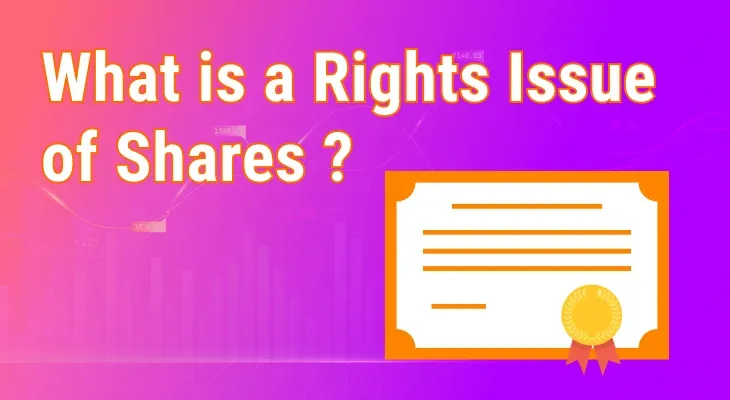
What is a rights issue?
As an investor, you need to know the different corporate actions a company can initiate. Among the different non-cash corporate actions possible, a rights issue is one of the most common. What is the rights issue of shares and why does a company opt for it? Here is everything you need to know.
In a rights issue, a company gives its existing shareholders the right to purchase more shares. Since the shareholders get to purchase shares directly from the company instead of the secondary market, the price of the shares is usually set lower than its current market price. The number of shares that an existing shareholder is eligible to apply for is dependent on the number of shares they hold.
Purchasing more shares through a rights issue is not mandatory. For instance, a shareholder who doesn’t wish to subscribe to the issue may choose to either let the right expire or transfer it to another shareholder.
Why Do Companies Offer Rights Issues to Their Shareholders?
A rights issue of shares is a way for companies to raise additional capital from their existing shareholders. It involves offering more shares at a discounted price, usually in proportion to the number of shares the shareholder already owns. But why would a company opt for this method of fundraising?
There are several reasons:
- Business Expansion: A company may need funds to fuel growth plans, such as launching a new product, entering a new market, or setting up additional facilities.
- Debt Reduction: Rights issues can be used to pay off existing loans, improving the company’s financial health.
- Working Capital Needs: In some cases, companies simply require more liquidity for day-to-day operations or short-term requirements.
- Regulatory or Strategic Requirements: At times, companies may need to improve their capital adequacy ratio or meet other regulatory norms.
The benefit for shareholders is that they get the opportunity to buy additional shares at a lower price, potentially increasing their future returns if the company performs well. Since a rights issue is offered only to existing shareholders, it also helps preserve the ownership structure and control.
When Should an Investor Participate in a Rights Issue?
Deciding whether to participate in a rights issue depends on the investor’s confidence in the company’s future. If the company is raising funds for a strong reason, like expansion or reducing debt, and has sound financials, subscribing may be beneficial.
Participate when:
- You believe in the company’s long-term growth.
- The issue price is significantly lower than the current market price.
- You wish to avoid dilution of your ownership.
- The company has a good track record of capital utilisation.
However, if you’re unsure about the company’s reasons or financial health, it's better to review the offer thoroughly or consult a financial advisor before investing.
Working of Rights Issue Explained
Here’s how a rights issue of shares typically works:
- Announcement: The company announces the rights issue with terms like issue price, ratio (e.g., 1:3 – meaning 1 new share for every 3 held), and record date.
- Record Date: Only shareholders who hold shares as of this date are eligible for the offer.
- Ex-Date: Ex-date is usually one day before the record date. If you buy shares on or after ex-date, you may not be eligible for the rights issue.
- Offer Period: Eligible shareholders are given a window to accept the offer, buy additional shares, or renounce (transfer) their rights.
- Payment and Allotment: Investors pay for the additional shares, and the company allots them within the stipulated time.
The right issue meaning is straightforward: existing shareholders get the "right" (but not obligation) to buy more shares, often at a discount, helping the company raise funds while rewarding loyal investors.
Features of a rights issue
Now that you’re aware of the meaning of the rights issue, let’s take a quick look at some of the unique features of this non-cash corporate action.
A rights issue gives existing shareholders preferential benefits.
The existing shareholders only get the right and not the obligation to purchase more shares of the company.
The shares are generally offered at a discounted price compared to their current market price.
A rights issue is an inexpensive way for companies to gain access to capital, since they don’t have to pay any fees to underwriters or book-running lead managers (BRLMs).
A shareholder may choose to sell the rights to other investors through the exchange or via an off-market transaction.
If a shareholder chooses to let the rights expire, it can lead to a dilution in shareholder’s ownership.
The number of rights shares that shareholders can apply for is determined by the number of shares they currently hold.
Reasons for a rights issue
A company might opt for a rights issue for several different reasons. Here are some of them.
When a company needs additional funds but wants to keep the voting rights of existing shareholders intact
When other sources of funding like debt financing are unavailable or expensive
When a company wants to improve its debt-to-equity (D/E) ratio
Example of a rights issue
Let’s assume that a company announces a rights issue at a 1:4 ratio. This means that for every 4 shares owned by an existing shareholder, they’re entitled to purchase 1 share. Now, say the current market price of the same company is ₹1,280 per share, whereas the rights issue may be priced at ₹1,000 per share.
Given these parameters, if you currently own around 2,000 shares of the company, you are eligible for the rights issue at a 1:4 ratio. Here’s how this would work.
The number of shares you’re eligible for = 500 shares (2,000 shares ÷ 4)
The amount that you would have to pay = ₹5 lakh (500 shares x ₹1,000 per share)
The total number of shares that you would own after exercising the rights issue = 2,500 shares
Conclusion
A rights issue is beneficial for both the company and its shareholders. While the company gains access to capital via a more inexpensive channel, the shareholders get to enjoy a discounted price on their shares. That’s not all. Unlike a follow-on public offering (FPO), where the voting rights of existing shareholders get diluted, the voting rights remain intact if the rights issue is exercised.
FAQ
How is the price for a rights issue determined?
The price of a rights issue is typically set at a discount to the current market price to encourage existing shareholders to subscribe. It reflects the company’s fundraising needs, market conditions, and investor sentiment, while still aiming to be attractive and fair to shareholders.
Is a rights issue taxable?
The act of receiving rights is not taxable. However, if you sell your rights entitlement or later sell the shares acquired through a rights issue, capital gains tax may apply based on holding period and applicable tax rules. It's advisable to maintain proper records for tax purposes.
How is a rights issue different from a bonus issue?
A rights issue involves buying additional shares at a discounted price, whereas a bonus issue provides free shares based on existing holdings. Rights issues raise new capital for the company; bonus issues do not, they simply capitalise reserves to reward shareholders.
Is a rights issue good or bad for investors?
A rights issue cannot be described as simply good or bad. It depends on the company’s purpose and financial position. If funds are raised for productive use and the business outlook is positive, it can benefit investors. However, frequent or poorly explained issues may signal financial stress.


